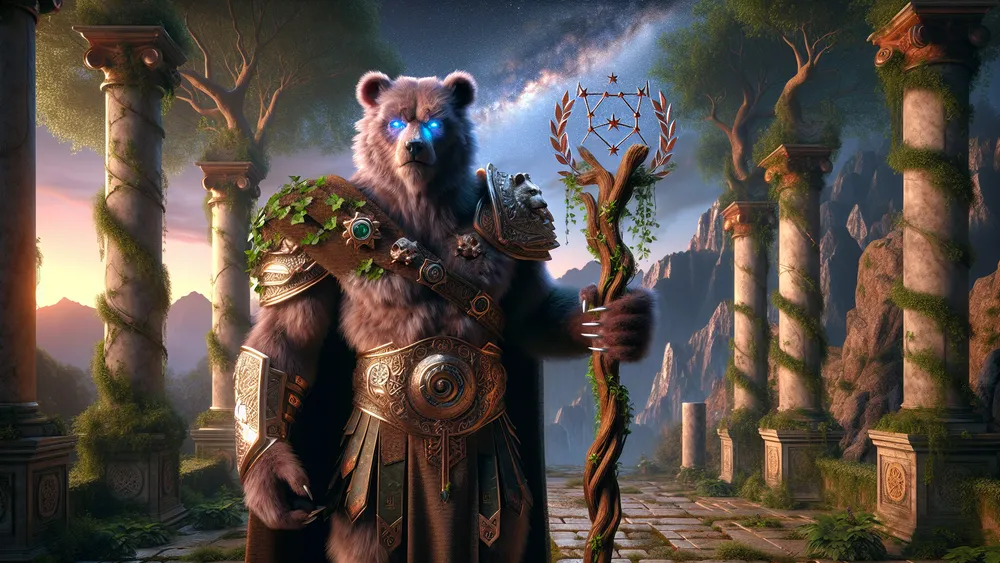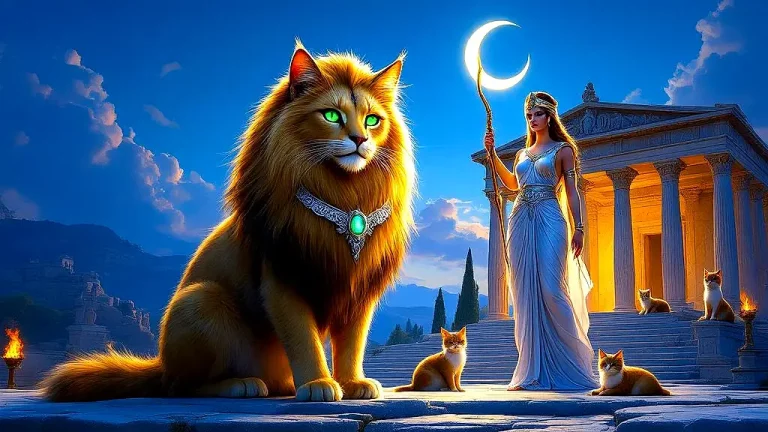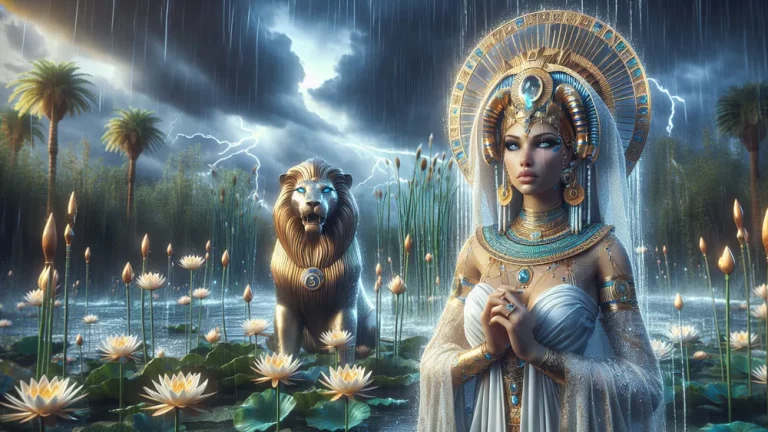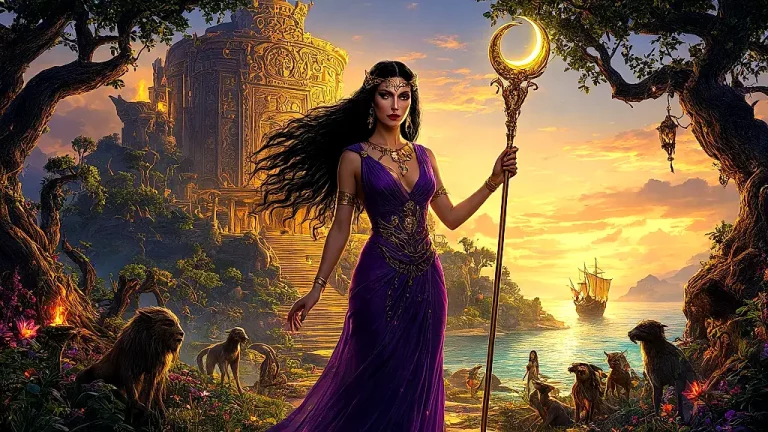Arktos In Greek Mythology: The Meaning And Origins Of ‘Bear’
Do you ever think about why bears – those big animals people think about when they imagine the wild – were such a big deal to ancient societies? In ancient Greece, the word “Arktos”, which means “bear” in old Greek, had meanings that were both simple and complicated. Bears were more than just strong animals – they became part of myths, astronomy, language, and cultural traditions.
Key Points:
- Arktos means bear in Greek and comes from an old language called Proto-Indo-European.
- Callisto, a nymph, became a bear and was turned into the constellations Ursa Major and Ursa Minor with her son.
- The constellations tied myths to the stars and were used for guidance, like Ursa Minor’s Polaris.
- Bears symbolized strength, care, and protection, and connected to Artemis, goddess of the wild and children.
- The Bear Dance (Arkteia) was a ritual for girls to honor Artemis and prepare for adulthood.
- The Arctic got its name because of the bear constellations in the northern sky.
- Other cultures, like the Romans, had different views on bears, focusing more on control over the wild.
They had a role in ideas about the gods, the universe, and ceremonies about growing up or safety. For instance, look at the stars. The constellations Ursa Major and Ursa Minor had stories connected to them. These tales involved a nymph called Callisto and her son Arcas, linking bears to both the sky above and life on Earth below.
Even the Arctic, which literally means “the place of bears,” got its name because of this ancient connection. So in this blog, we will jump into where “Arktos” came from, what it meant to the Greeks, and how it still helps us understand bears in stories and the stars.
Arktos: Overview and Key Facts
| Aspect | Key Facts |
|---|---|
| Meaning of “Arktos” | “Arktos” means “bear” in ancient Greek and came from Proto-Indo-European, an old language older than Greek. |
| Linguistic Influence | The word “Arktos” led to the name “Arctic,” meaning “land of the bear,” because of constellations called Ursa Major and Ursa Minor. |
| Mythological Associations | The story of Callisto and her son Arcas, who became bears and then constellations, is closely linked to “Arktos.” |
| Astronomical Significance | Ursa Major, which means the Great Bear, and Ursa Minor, the Little Bear, are constellations important for finding direction. |
| Symbolism in Greek Culture | In Greek culture, bears stood for strength, gods protecting people, motherly care, and how the wild and caring sides could mix. |
| Role in Rituals | Bears were connected to the goddess Artemis, and Athenian girls danced the Bear Dance (Arkteia) as a way to mark growing up. |
| Cultural Legacy | Even now, “Arktos” is part of modern language (in words like “Arctic”) and astronomy, where bear-related constellations matter. |
| Representations in Art | Bears could appear in pottery, statues, and pictures of Artemis and Callisto. |
Where ‘Arktos’ Comes From in Greek Myths
To understand why ‘Arktos’ is important in Greek culture, we need to think first about where the word comes from and the stories tied to it. The word’s beginnings and its connections to myths are important to know. There were many myths and ideas people had about ‘Arktos’ that gave it meaning.
So, we should look at its origins and how it ties into the myths and culture of ancient Greece.
The Roots of the Word: How ‘Arktos’ Traces Back to Proto-Indo-European
The word “Arktos”, which means “bear” in ancient Greek, comes from an older language called Proto-Indo-European (PIE). It is one of the earliest words used for this strong animal, based on the reconstructed term h₂ŕ̥tḱos. Experts in language compared words from different languages, like Latin (ursus) and Sanskrit (ṛkṣa), to figure out that these words all came from the same source.
Proto-Indo-European speakers moved to new places, and their languages changed. Over time, h₂ŕ̥tḱos became “Arktos” in Greek. It reflects how spoken sounds shifted in different ways among these languages. The Greeks didn’t only use “Arktos” to talk about bears. They also gave this name to regions in the northern sky. These areas were linked to constellations like Ursa Major and Ursa Minor, star groups that reminded them of bears.

That is where the name “Arctic” comes from – because of the connection to the bears in the stars. By linking these constellations and bears, the Greeks connected their language with the sky, the myths they told, and how they understood the world around them.
The Greek word Arktos, meaning bear, originates from the ancient Proto-Indo-European term h₂ŕ̥tḱos and also inspired the name Arctic because of its link to bear-shaped constellations in the northern sky.
Bears in the Stars: Arktos and the Greek Cosmos
In Greek stories, two famous star groups – Ursa Major, or the “Great Bear,” and Ursa Minor, or the “Little Bear” – had important meanings and connections to myths. In one version of the story, Callisto, who was loyal to Artemis, attracted the attention of Zeus. Like in many stories, Hera became angry at Zeus, and her rage was directed at Callisto. Because of this, Callisto was turned into a bear.
Later, Callisto – still a bear – saw her son, Arcas. But he didn’t know who she was. He was hunting, and when he was about to kill her, Zeus stopped him. To save them both, Zeus put Callisto and Arcas in the stars. Now these two star patterns – Ursa Major and Ursa Minor – keep their story alive.
For the Greeks, these stars were more than just patterns in the night sky. They thought of Ursa Major, the larger of the two, as a sign of courage, sadness, and loyalty – while Ursa Minor, which has Polaris, or the North Star, symbolized guidance and safety. Because Polaris always points north, it helped travelers find their way.
Over time, people began to see these stars as reflecting not just human emotions, like hope and pain, but also as reminders of survival and connections between families. Greeks used stories like the one about Callisto and Arcas to give meaning to the stars above them, connecting the sky and their everyday life in a way that tied everything together.
| Constellation | Name Meaning | Mythological Origin | Position in the Sky |
|---|---|---|---|
| Ursa Major | “Great Bear” | Callisto turned into a bear and put in the sky by Zeus. | Northern sky; easiest to find in spring. |
| Ursa Minor | “Little Bear” | Arcas, Callisto’s son, placed near her by Zeus. | Northern sky; includes Polaris, the North Star. |
What the Greeks Thought About the Arctic
To the ancient Greeks, the Arctic – meaning the “land of bears” – was connected to the stars in the northern sky, especially the constellations Ursa Major and Ursa Minor. They named this region after the term “Arktos” because of these bear-like star patterns. The stars helped them link northern places with the myths tied to the bears they saw above. For the Greeks, this wasn’t just about geography.
They believed that stars and places were connected by stories. The Greeks didn’t travel to what we now call the Arctic Circle, but they still had ideas about the “lands in the north.” These ideas came from the stars. The stars of Ursa Major could easily be seen in the northern sky, and these patterns helped guide sailors who depended on them to travel.
Because they connected these constellations to their stories about bears, they thought the farther north you went, the more those stories mattered. The name “Arctic” came from their idea that the stars and the Earth shared meaning – while the constellations were in the sky, they also gave names and ideas about the world below.
Just like how today’s names often come from cultural or natural features, Greeks thought the stars above gave real meanings to places on Earth. Ursa Major and Ursa Minor, in particular, tied stories of strength and survival to the idea of the northern lands.
How the Bear Symbol Appeared in Greek Life
After we’ve looked at how bears were connected to myths and the stars, it is also important to look at their role in Greek culture. Bears were seen as important symbols that stood for strength, safety, and gods.
Bears as a Symbol of Power, Protection, and the Divine
In ancient Greek culture, bears became strong symbols of both power and care. To the Greeks, bears were powerful animals in the wild because they had great physical strength and could control the world around them. Beyond their strength in nature, they also appeared in Greek myths, which made their connection to power even stronger.
For example, bears were connected to Artemis, the goddess who guarded wild animals and young women. She was fierce in protecting those under her care. The Greeks saw how bears defended their cubs with unwavering loyalty, meaning they were not only seen as symbols of strength but of care as well.

In addition to their role as strong animals, bears also stood for spiritual protection in Greek traditions. One important example is the myth of the Arktoi, where girls acted as “little bears” to honor Artemis during a ritual. This ceremony marked a transition in life, showing the connection between bears and change. In some myths, bears also rescued or helped children, often because of Artemis’s influence.
People even made offerings and carved temple artwork with bears, which reveals how the animals were part of religious life.
Below is a simple summary of the bear’s importance:
- Strength: Stood for physical power and control over nature.
- Motherhood: Represented mothers caring for and protecting their young.
- Sacred Meaning: Linked to Artemis and ceremonies in her honor.
- Stars and Myths: Stories about stars connected them to divine guidance.
Artemis and Her Sacred Bond with Bears
Artemis, the Greek goddess of hunting, wild places, and young girls, had a strong bond with bears. She was both a fierce hunter and a protector of children. On one side, she showed the strength and independence of the natural world by moving through wild places. On the other, she kept children safe, especially young girls, and watched over their growth.
The Greeks believed that bears, with their strength and their ability to defend their young, represented both. Because bears could be wild and protective at the same time, they were important symbols connected to her.
One of the strongest links between Artemis and bears can be seen in the Arktoi ritual. During this ceremony, girls dressed as “little bears” to honor her and to show she was their guardian. This ritual also marked a time in life when girls started transitioning to adulthood, showing how bears symbolized change and guidance. In addition, the Greeks created images of Artemis with bears or even wearing bear skins.
These artifacts, which were found in temples and religious sites, make it clear that Artemis and bears had an essential connection in Greek traditions.
Artemis was strongly linked to bears, symbolizing both wild strength and protective care, as seen in rituals, symbols, and traditions honoring her role as a guardian of girls and nature.
How Bears Were Seen in Myths and Art
After we’ve looked at Artemis’s connection to bears and the meaning they held, it’s time to think about how these animals were seen in Greek myths and art. Bears were important symbols in ancient Greek stories and artwork. They stood out in myths and also appeared in religious traditions.
The Callisto Myth: A Mortal Bear Turned into a Constellation
Callisto, who was one of the followers of Artemis, had promised to live a pure life and never break her vow. She stayed loyal to the goddess for a long time, but one day Zeus tricked her. He disguised himself and caused her to break her vow because she became pregnant.
When Artemis found out, some versions say she was so angry at Callisto that she banished her. But in other versions, it was Hera, Zeus’s wife, who punished her instead. Hera, jealous again because of her husband’s cheating, changed Callisto into a bear. As a bear, Callisto wandered through the wild, far from her old life. She no longer looked human and had to learn how to live as an animal.
Meanwhile, Callisto’s son, Arcas, lived and grew up not knowing who his mother really was. One day, while he was hunting, he saw a bear. It was Callisto, but he didn’t know. He almost killed her. At the last second, Zeus stepped in and stopped him.
To solve everything, he placed Callisto and Arcas in the sky as constellations: Callisto as Ursa Major, and Arcas as Ursa Minor. The story teaches lessons that were important to the Greeks. Hera’s jealousy, which hurt Callisto instead of Zeus, means how dangerous anger can be when it’s pointed at the wrong person.

Being turned into a bear, on the other hand, shows the pain of being forced to change and lose what you had before. Even though the story has sadness, in the end, Zeus gave Callisto and Arcas a place in the stars, which means they were remembered forever. This gave people hope that even when unfair things happen, there could still be kindness later.
The Bear Dance (Arkteia): A Ritual for Artemis
The Bear Dance, or Arkteia, was a ceremony done by young girls in Athens to honor Artemis, the goddess who helped protect children and guided them to adulthood. The ritual happened at Brauron, which was one of the main places where Artemis was worshiped. It had a lot of meaning for both the people’s religion and their society.
During the event, the girls were called “arktoi,” or “little bears,” which connected them with Artemis’s sacred animal, the bear. This was a way for the girls to prepare for becoming adults. It was the time when they stopped being children and got ready to take on new roles, including marriage.
According to myths, the ritual might have started because a sacred bear was killed at Brauron, which led Artemis to demand that all young girls act as “arktoi” to make up for it. In the ritual, each girl wore a yellow robe. This plain outfit meant that the girls had become bears during the event.
They danced the way bears moved, which was important because bears were special to Artemis. By doing this, they connected themselves to the wild and to nature. The dance wasn’t just for Artemis; it also allowed them to begin growing up, to move closer to adulthood.
The girls also brought gifts for the goddess, like cakes, little figures, or other offerings, to show their respect and thanks for her. This made the ceremony about more than just change – it was also about being part of the community and staying linked to Artemis. Everything in the Bear Dance had meaning.
The clothes, the actions, and the gifts all showed how the girls were leaving their old lives behind and getting ready for something new.

The Bear Dance was extremely important to society because it wasn’t only a spiritual event. It was how people reminded everyone of the connection between Artemis and young girls and how the goddess gave protection. Below are the main parts of the ritual:
- Preparation: The girls wore yellow robes to show they were now acting as “arktoi,” or little bears.
- Dance: They performed movements like a bear, which connected them to Artemis and her link with wild animals.
- Offerings: Cakes, small figures, and other gifts were given to the goddess to show devotion.
- Growing Up: The ritual meant the girls were now ready to leave their childhood behind and move towards being adults.
How Other Mediterranean Cultures Viewed Bears
The Greeks thought bears had a lot of importance in their religion and ceremonies. But, at the same time, there were other Mediterranean cultures nearby. People in those places had their own ideas about what bears meant. These ideas weren’t always the same as the Greek beliefs. Some groups gave bears a special role too, but how they saw them – what they meant and why they mattered – was sometimes very different.
Arktos in Roman Myths: Diana and the Bear
In Roman mythology, Diana was the goddess of hunting, the moon, and the natural world. A lot of what Diana stood for came from Artemis, her Greek counterpart. Like Artemis, Diana was connected to wild animals. But even though bears weren’t the main animal tied to her, she was still deeply linked to the natural world and places untouched by civilization.
Diana kept the same ideas of balance between the moon and nature, ideas that began with Artemis. While the Greeks saw the bear as a symbol of strength, caring instincts, and divine connection, the Romans thought differently.
Many of Artemis’s myths, including Callisto’s story, were retold for Diana, but the new versions focused more on how she protected what was proper in society. For example, Diana represented purity and helped young women, but the Romans saw the bear less as a symbol of transformation and more as a creature of the wild – a creature Diana could keep under control.
The Romans didn’t picture bears in the same way the Greeks did. The Greeks used bears to explain lessons about change and morality. But for Roman culture, their ideas were clearer and simpler. Diana’s festivals showed this focus. At Nemoralia, one of her most important festivals, Diana was praised for her connection to nature. However, this celebration also reflected Roman beliefs about keeping order between people and the wild.
While Diana was important as the goddess of the wilderness, Roman rituals described her as someone who helped to manage and control nature. Their stories and practices showed the same values – order, stability, and power over chaos. So, for the Romans, a bear didn’t just mean wildness or divine strength, as it often did for the Greeks.
A bear came to mean control over something wild. This change in how bears were seen matched Rome’s general values about controlling and disciplining the untamed. Even though there were differences, Diana’s image stayed connected to themes from Artemis. She ensured a link between people and the divine, just as her Greek counterpart did.
All the Greek Abstract and Natural Forces Related to Arktos
The idea of Arktos in Greek mythology ties into both natural and unseen forces. For the Greeks, this showed how much they connected nature and the wider universe. Bears stood for more than just physical things, such as strength or living in the wilderness.
They also stood for bigger ideas, like the stars and the gods’ power, which were harder to see or understand. In Greek myths, Arktos linked simple, physical parts of the world with invisible powers. This says a lot about how they thought about nature, their place in it, and how they lived alongside these ideas every day.
For more details – especially about other natural and abstract forces – readers can look at this list of all the Greek Abstract and Natural Forces, which explains this connection in greater depth. The Greeks often saw the visible and invisible worlds as tied together, and Arktos is a good example of how they made sense of both.
FAQs
1. Why did Callisto become a bear in Greek mythology?
Callisto became a bear in Greek mythology because Hera, out of jealousy over Zeus’s affair with her, transformed her as punishment.
2. How did Greeks conceptualize constellations?
Greeks conceptualized constellations as divine representations of mythological figures and moral lessons woven into the cosmos.
3. Why was Artemis connected to bears?
Artemis was connected to bears because they symbolized her dual role as a fierce protector of the wild and a nurturer of young life.
4. What were the cultural roles of bears in Greek life?
The cultural roles of bears in Greek life centered around their symbolism of strength, protection, and their sacred connection to gods like Artemis.







